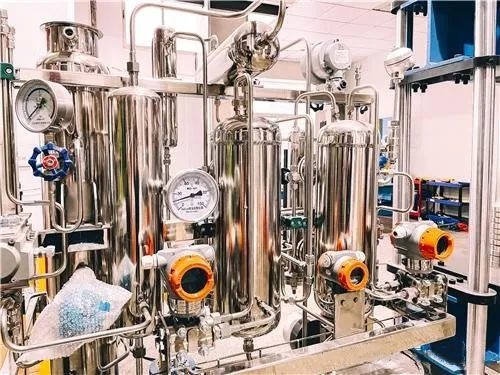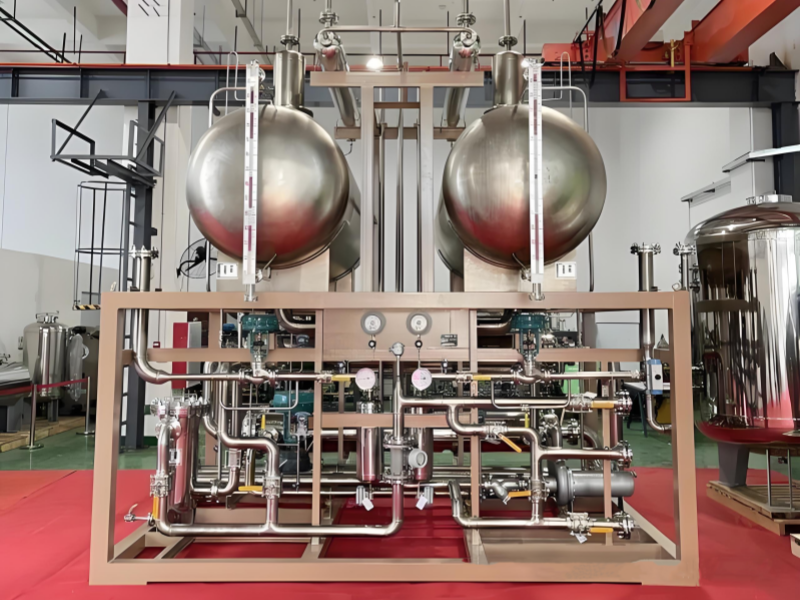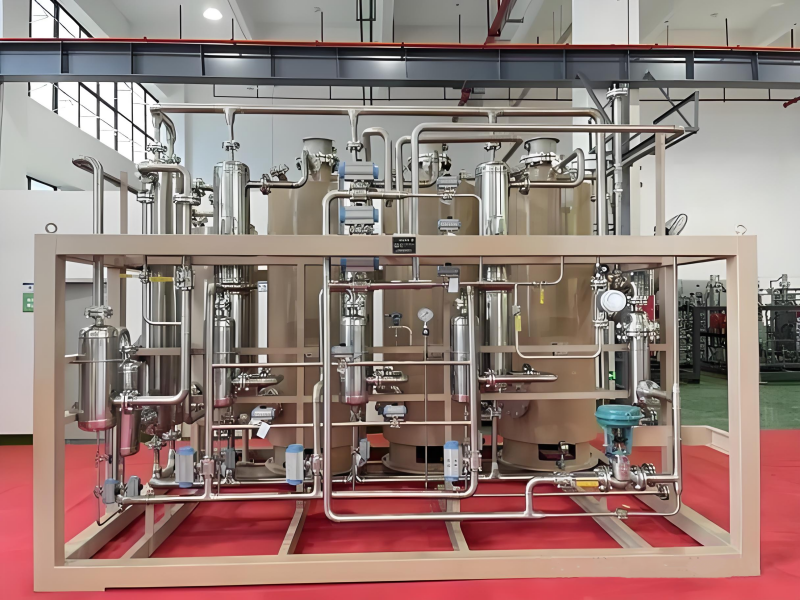BETTER TOUCH BETTER BUSINESS
Contact Sales at KAIDI.
Differential pressure transmitter is a typical self-balancing detecting instrument, which is used to measure the pressure difference between two pressure interfaces (generally positive and negative pressure ends) and convert this differential pressure value into a standard signal output. It usually consists of a high-precision pressure sensor and a signal processing unit, and is widely used in liquid, gas or steam level, flow and pressure measurement.
I. Differential pressure transmitter working principle
The basic principle of the differential pressure transmitter is a space with sensitive elements (multi-membrane box) split into two chambers, respectively, to the two chambers to introduce pressure, the sensor in the two sides of the pressure under the joint action of the displacement (or displacement of the tendency), the amount of this displacement and the two chambers of the difference between the pressure (differential pressure) is proportional to the displacement will be converted to reflect the size of the difference in the size of the standard signal output. Specifically, the pressure of the medium under test acts on the isolation diaphragm of the high and low pressure chambers of the differential pressure transmitter, and is transmitted to both sides of the measurement diaphragm through the isolation piece and the filling liquid inside the element. Measuring diaphragm and the electrodes on both sides of the insulating sheet each form a capacitor. When the two sides of the pressure is not consistent, resulting in the measurement of the diaphragm displacement, so that the two sides of the capacitance is not equal, through the oscillation and demodulation link, converted into a signal proportional to the pressure.

II. Application scenarios
Industrial process control:In the production process of chemical, petroleum, natural gas and other industries, it is used to monitor and control the pressure difference of the fluid in the pipeline to ensure the stable operation of the production process. For example, monitoring the flow rate of liquid or gas in pipelines, adjusting the opening of valves, etc.
Level measurement:Utilizing the differential pressure transmitter working principle of hydrostatic pressure change generated by the liquid column when the liquid level in the container changes, the liquid level height is determined by measuring the differential pressure. Commonly used in tanks, tanks, reactors and other containers level monitoring.
Filtration system monitoring:It is used to monitor the clogging of filters in liquid or gas filtration systems. As the filter is clogged, the pressure difference between its two sides will gradually increase, and when the pressure difference reaches a certain threshold, it can be judged that the filter needs to be cleaned or replaced.
Air conditioning and ventilation systems:Monitor and regulate air flow and air quality in buildings to ensure comfort and energy efficiency in the indoor environment.
Gas flow measurement:Calculate the gas flow rate by measuring the pressure difference of the gas in the pipeline, widely used in gas, ventilation and other systems.

III. Selection requirements
Measuring range: To specify the maximum and minimum values of the measured pressure difference, the range of the selected china differential pressure transmitter should be greater than about 1.5 times the maximum pressure difference that may occur in the system to prevent instantaneous peaks from destroying the sensor, and to ensure that there is sufficient accuracy within the normal measuring range. For example, if the pressure difference in the system fluctuates from 0-100kPa, a differential pressure transmitter with a range of 150kPa or more should be selected.
Nature of the medium: consider the nature of the measured medium, such as whether the viscous liquid, mud and other easy to block the pressure interface medium, and whether corrosive and so on. For corrosive media, you need to select the appropriate isolation membrane and the material in contact with the media to ensure the service life of the transmitter.
Accuracy requirements: Select the appropriate differential pressure transmitter according to the application scenario of the measurement accuracy requirements, the higher the accuracy, the higher the price is usually. A balance between accuracy and cost needs to be considered.
Temperature range: Understand the normal operating temperature range of the transmitter and the temperature compensation range, to ensure that temperature changes in the actual use of the environment will not affect the transmitter's performance and measurement accuracy.
Output Signal: According to the requirements of the control system to choose the appropriate output signal, common 4 ~ 20mA, 0 ~ 5V, RS485 and so on. At the same time to consider the distance of signal transmission, whether there is electronic interference and other factors.
Explosion-proof requirements: In flammable and explosive hazardous environments, such as petrochemical, coal mining and other industries, it is necessary to choose a china differential pressure transmitter that meets the corresponding explosion-proof standards, such as explosion-proof or intrinsically safe transmitters, in order to ensure the safety of use.
Installation: Choose the appropriate installation method according to the installation conditions and space limitations of the site, such as direct mounting, flange mounting and so on. At the same time, it should be noted that the installation location should be easy to maintain and observe, and to ensure that the transmitter's “+” “-” pressure chamber elevation is the same.
Uniform selection: If you need to use more than one differential pressure transmitter in an engineering project, you should try to choose the same brand, the same model of the product, in order to facilitate the management and maintenance, and to reduce the type and quantity of spare parts.

IV. Troubleshooting
(1) Abnormal output signal
Check the power supply: Make sure the power supply of the transmitter is normal, including whether the voltage is stable and whether it meets the working requirements of the transmitter. Power supply failure may lead to unstable output signal or no output.
Check Wiring: Check that the transmitter is properly and securely wired for loose, shorted or disconnected wiring. Incorrect wiring or poor contact will affect signal transmission.
Check the sensor: the sensor is the core component of the differential pressure transmitter china, if the sensor is damaged or malfunctioned, it will lead to abnormal output signal. You can judge whether the sensor is normal by checking its resistance value, capacitance value and other parameters.
Check environmental factors: Temperature, humidity, electromagnetic interference and other factors in the environment may affect the performance of the transmitter. For example, a high temperature environment may cause the accuracy of the transmitter to drop, and electromagnetic interference may cause signal distortion.
(2) Inaccurate pressure measurement
Zero Calibration: A zero calibration is performed to ensure that the transmitter output is zero with no pressure differential. If the zero point is shifted, it will result in inaccurate measurement results.
Checking the pilot tube: Check the pilot tube for problems such as clogging, leaks, or air bubbles. Problems with the pilot tube can affect pressure transfer and lead to measurement errors.
Check the range setting: Make sure the range setting of the transmitter is correct and matches the actual measurement range. Improper range settings can lead to out-of-range measurements or decreased accuracy.
(3) No output from transmitter
Check the power supply and circuit: first check whether the power supply is normal, and then check whether the circuit of the transmitter is faulty. You can use a multimeter and other tools to test to see if the resistors, capacitors, diodes and other components in the circuit are normal.
Check Sensor Connection: Check that the connection between the sensor and the transmitter is good and not loose or disconnected. If the sensor connection is poor, the transmitter will not be able to receive the pressure signal, resulting in no output.
We are here to help you! If you close the chatbox, you will automatically receive a response from us via email. Please be sure to leave your contact details so that we can better assist